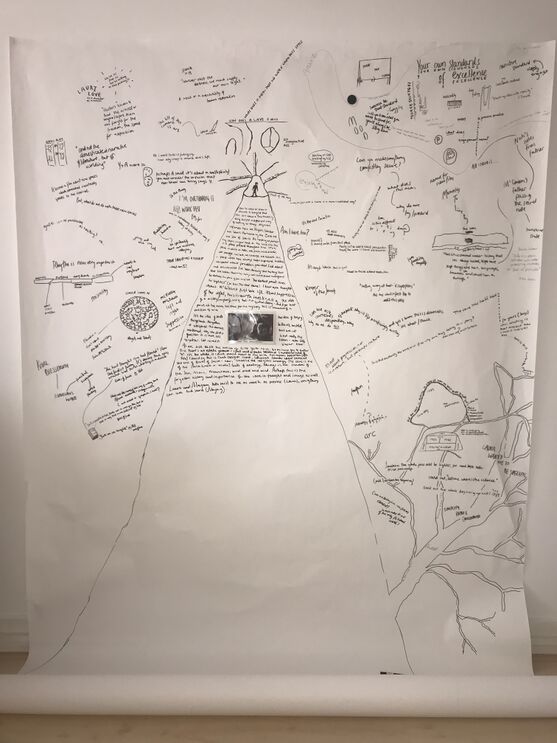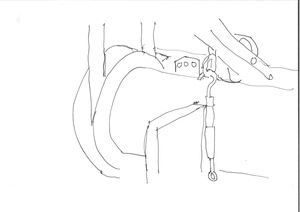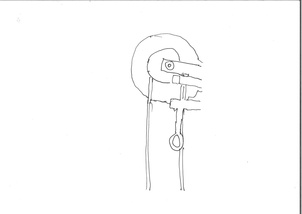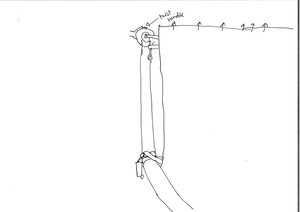TEXTONPRACTICE4thDRAFT(real): Difference between revisions
No edit summary |
No edit summary |
||
| Line 1: | Line 1: | ||
[[File:Process for project.png|thumb| | As it stands now “Will You Meet Me Here?” is a 4 minute single channel video. The video has been graded black and white, and comprises of footage made using a go-pro camera and 360 camera. | ||
{{youtube|iHJA-7eTu7w}} | |||
“Will You Meet Me Here” explores the human use of caves, holes and cavities throughout history. Although there are multiple references to various ‘cavities’, the script is anchored by three locations. The first is a cave used for smuggling contraband during the 1700s on the Sussex coast of England. The second is a software hole, also known as a Zero Day, which can be used by a ‘hacker’ to enter a computer system inconspicuously. The third is a monitoring room, in which two operators observe video recording of a cave. | |||
The initial idea resulted from two activities: walking and reading. As I walked along the Sussex coast I brushed across constant references to its historical link to smuggling and the importance of the naturally formed caves in this activity. The caves are where clandestine exchanges took place. | |||
At the same time I was finishing reading a book - ‘This is How They Tell Me The World Ends’. This is a book I’d come across through my ongoing interest in existential risk. The book chronicles a journalists furrow into the world of Zero Days, and the Zero Day Market. A zero day is “a software bug that allows a hacker to break into your devices and move around undetected”(Perlroth, 2021). | |||
I saw a link here, between the Zero Days underground market, and the underground market of contraband in 1700s. Also, the potential to make physical the digital space through the analogy of the cave. | |||
So, I begun to gather material: writing in my notebook, scanning the internet for images of the caves, buying old photographs of the different caves, drawing the cliff space, writing anything I felt linked these two points on yellow post it notes and then pinning all of this to the wall of my studio. I sat with these in my studio for over a month before the script emerged, feeling deeply frustrated most of the time. The link felt jointly tenuous and too direct, and I was unsure how it would all come together as a whole. | |||
The script evolved as a result of two separate writing exercises. The first came from Natasha, who (following a reading of Anne Boyer's text 'Questions For Poets’) asked us to write a text formed around a question from our practice. “Tell me what do you see?”, was the question I gave myself, and from here arose the two ‘smuggler’ characters and a narrator. | |||
The second writing exercise was given by Laura, who asked us to write a text from a non-human perspective. Quite naturally, I decided to write from the perspective of the cave, who I later realised was the ‘narrator’ from the previous writing task. It was in Laura’s session I wrote the bones of the opening monologue “a hole in the wall, a hole in time…”. | |||
The shoot itself took place over two trips to England, a couple of months apart. Over these two trips, I visited the caves on six separate occasions. First, to scout locations, four times to shoot and then finally to collect sounds. | |||
In terms of shooting, I went once with a friend who has experience in shooting in these types of locations. The others I shot by myself, sometimes alone but often with someone to accompany me as the caves are quite remote and tidal so it is not the safest location. | |||
I used five different cameras across the shoot: a DSLR, two types of 360 cameras, a phone camera and a GoPro. I also used two gimbals, one for the DSLR and one for the phone. I recorded sound with a zoom H5. | |||
The first shoot ended up being more exploratory, then it was “productive” per se. In other words, I came back with more questions then I did useable footage. It was a vital couple of days, to understand all the practicalities of shooting within a tidal cave. | |||
I returned to Rotterdam, and reviewed the footage. Aside from practicalities, it became apparent that the quality of the 360 camera was evocative of the mood I desired. In fact, one 360shot even inspired a new scene in the script - where two operators look at distorted footage of a cave they have been asked to film. | |||
For the second trip, I had a much clearer idea of what images I wanted, as well as a near complete script. My equipment bag was much lighter, I carried a 360 camera and GoPro only. Both light cameras that could be moved easily but still they could shoot to the quality I wanted. Further, I had been recording sound each time I went to the cave but gave myself a dedicated day to record: atmospheric sound of the cave, the waves lashing on the shore, footsteps on a pebbled beach, whispering within the cave. | |||
There was another element to the process, which was working with actors. This is something I did more intuitively then any other part of the process, and for this reason I think it’s an area I would like to dedicate more time to developing my approach. | |||
Returning to Rotterdam again, I begun the editing process. The editing process was punctured with various feedback moments, and this loop of editing a draft and having a feedback session, and then re-editing a new draft was a productive structure for me, and so one that I will use again. | |||
-[[File:Process for project.png|thumb|962x962px|none]]I want to continue with this project, and in order to develop it I am working on a practice I call ‘Wall Writings’. In this practice, large rolls of paper (2 meters wide) are measured out to just above my head, and then stuck onto the wall in my living space. On these scrolls of paper I practice a number of things: | |||
free writing, jotting down ideas on the go, drawing images from current work/future work, writing in shapes/word art, long form essayistic writing, fears/ worries, lyrics, recurring questions, cataloging feedback and drawing shapes of narratives etc. | |||
All of these activities come together to form a kind of map on the wall. | |||
[[File:Wall as of 15thFeb23.jpg|center|thumb|743x743px]] | |||
Map making as a way of tracking the progression of thought, of eliciting connections, of moving whilst making, of making non-digital work, of forming images through word and discovering non-conventional narrative shapes. Fundamentally, this act stems from a desire-cum-frustration to reveal the circuitry/wiring between ideas I’ve seen. A process-practice with means to an end (a function in other words) but also a form of simple self expression in and of itself. The dual nature of this act is important. | |||
I am currently only writing in black ink on white paper. I use specific pens which have a soft felt tip, with an inky feel. I stand, squat or sit on the floor (being physically dynamic is important to my personal experience and it of course has an effect on the output). I have not cut the paper yet, but I do intend for there to be an end to this wall writing. Then I will begin another. I would like to create a rolling paper machine from hand inspired by the artist Van Neistat, he replied to an email I sent him and told me how to make it. | |||
[[File:Rolling paper 1.pdf|thumb]] | |||
[[File:Rolling paper 2.pdf|thumb|302x302px]] | |||
[[File:Scan MFP-529 2711 001.pdf|thumb]] | |||
Alongside developing this project, I am trying to remove how central the finished work is to my practice, these works are destinations where I may arrive at, I circle, I return to but they are held by and do not exist without the roads that led me there, and the roads that do not. And this map making - it helps to stop thinking in a 'I need to make a thing' head space. | |||
Overall, my two major concerns are the feeling space and the narratological shape of a work. In short, a work must leave space for feeling, as well as hold a narratological shape that fits to the work. Narrative shape should not be assumed, but developed alongside everything else. So with this said I feel I stand on the shoulders of people (musicians, filmmakers, artists, novelist, psychologists) who play in a similar way: Olga Tokarczuk, Kendrick Lamar, Andre 3000, Mamoru Oshi, Andrei Tarkovsky, Pina Bausch, Karl Diesseroth etc. | |||
Revision as of 21:31, 7 March 2023
As it stands now “Will You Meet Me Here?” is a 4 minute single channel video. The video has been graded black and white, and comprises of footage made using a go-pro camera and 360 camera.
“Will You Meet Me Here” explores the human use of caves, holes and cavities throughout history. Although there are multiple references to various ‘cavities’, the script is anchored by three locations. The first is a cave used for smuggling contraband during the 1700s on the Sussex coast of England. The second is a software hole, also known as a Zero Day, which can be used by a ‘hacker’ to enter a computer system inconspicuously. The third is a monitoring room, in which two operators observe video recording of a cave.
The initial idea resulted from two activities: walking and reading. As I walked along the Sussex coast I brushed across constant references to its historical link to smuggling and the importance of the naturally formed caves in this activity. The caves are where clandestine exchanges took place.
At the same time I was finishing reading a book - ‘This is How They Tell Me The World Ends’. This is a book I’d come across through my ongoing interest in existential risk. The book chronicles a journalists furrow into the world of Zero Days, and the Zero Day Market. A zero day is “a software bug that allows a hacker to break into your devices and move around undetected”(Perlroth, 2021).
I saw a link here, between the Zero Days underground market, and the underground market of contraband in 1700s. Also, the potential to make physical the digital space through the analogy of the cave.
So, I begun to gather material: writing in my notebook, scanning the internet for images of the caves, buying old photographs of the different caves, drawing the cliff space, writing anything I felt linked these two points on yellow post it notes and then pinning all of this to the wall of my studio. I sat with these in my studio for over a month before the script emerged, feeling deeply frustrated most of the time. The link felt jointly tenuous and too direct, and I was unsure how it would all come together as a whole.
The script evolved as a result of two separate writing exercises. The first came from Natasha, who (following a reading of Anne Boyer's text 'Questions For Poets’) asked us to write a text formed around a question from our practice. “Tell me what do you see?”, was the question I gave myself, and from here arose the two ‘smuggler’ characters and a narrator.
The second writing exercise was given by Laura, who asked us to write a text from a non-human perspective. Quite naturally, I decided to write from the perspective of the cave, who I later realised was the ‘narrator’ from the previous writing task. It was in Laura’s session I wrote the bones of the opening monologue “a hole in the wall, a hole in time…”.
The shoot itself took place over two trips to England, a couple of months apart. Over these two trips, I visited the caves on six separate occasions. First, to scout locations, four times to shoot and then finally to collect sounds.
In terms of shooting, I went once with a friend who has experience in shooting in these types of locations. The others I shot by myself, sometimes alone but often with someone to accompany me as the caves are quite remote and tidal so it is not the safest location.
I used five different cameras across the shoot: a DSLR, two types of 360 cameras, a phone camera and a GoPro. I also used two gimbals, one for the DSLR and one for the phone. I recorded sound with a zoom H5.
The first shoot ended up being more exploratory, then it was “productive” per se. In other words, I came back with more questions then I did useable footage. It was a vital couple of days, to understand all the practicalities of shooting within a tidal cave.
I returned to Rotterdam, and reviewed the footage. Aside from practicalities, it became apparent that the quality of the 360 camera was evocative of the mood I desired. In fact, one 360shot even inspired a new scene in the script - where two operators look at distorted footage of a cave they have been asked to film.
For the second trip, I had a much clearer idea of what images I wanted, as well as a near complete script. My equipment bag was much lighter, I carried a 360 camera and GoPro only. Both light cameras that could be moved easily but still they could shoot to the quality I wanted. Further, I had been recording sound each time I went to the cave but gave myself a dedicated day to record: atmospheric sound of the cave, the waves lashing on the shore, footsteps on a pebbled beach, whispering within the cave.
There was another element to the process, which was working with actors. This is something I did more intuitively then any other part of the process, and for this reason I think it’s an area I would like to dedicate more time to developing my approach.
Returning to Rotterdam again, I begun the editing process. The editing process was punctured with various feedback moments, and this loop of editing a draft and having a feedback session, and then re-editing a new draft was a productive structure for me, and so one that I will use again.
-
I want to continue with this project, and in order to develop it I am working on a practice I call ‘Wall Writings’. In this practice, large rolls of paper (2 meters wide) are measured out to just above my head, and then stuck onto the wall in my living space. On these scrolls of paper I practice a number of things:
free writing, jotting down ideas on the go, drawing images from current work/future work, writing in shapes/word art, long form essayistic writing, fears/ worries, lyrics, recurring questions, cataloging feedback and drawing shapes of narratives etc.
All of these activities come together to form a kind of map on the wall.
Map making as a way of tracking the progression of thought, of eliciting connections, of moving whilst making, of making non-digital work, of forming images through word and discovering non-conventional narrative shapes. Fundamentally, this act stems from a desire-cum-frustration to reveal the circuitry/wiring between ideas I’ve seen. A process-practice with means to an end (a function in other words) but also a form of simple self expression in and of itself. The dual nature of this act is important.
I am currently only writing in black ink on white paper. I use specific pens which have a soft felt tip, with an inky feel. I stand, squat or sit on the floor (being physically dynamic is important to my personal experience and it of course has an effect on the output). I have not cut the paper yet, but I do intend for there to be an end to this wall writing. Then I will begin another. I would like to create a rolling paper machine from hand inspired by the artist Van Neistat, he replied to an email I sent him and told me how to make it.
Alongside developing this project, I am trying to remove how central the finished work is to my practice, these works are destinations where I may arrive at, I circle, I return to but they are held by and do not exist without the roads that led me there, and the roads that do not. And this map making - it helps to stop thinking in a 'I need to make a thing' head space.
Overall, my two major concerns are the feeling space and the narratological shape of a work. In short, a work must leave space for feeling, as well as hold a narratological shape that fits to the work. Narrative shape should not be assumed, but developed alongside everything else. So with this said I feel I stand on the shoulders of people (musicians, filmmakers, artists, novelist, psychologists) who play in a similar way: Olga Tokarczuk, Kendrick Lamar, Andre 3000, Mamoru Oshi, Andrei Tarkovsky, Pina Bausch, Karl Diesseroth etc.





